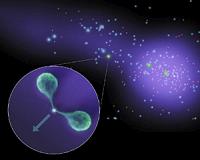 |
Liverpool, UK (SPX) Nov 25, 2010 A PhD student studying at Liverpool John Moores University's (LJMU) Astrophysics Research Institute has opened a new chapter in observations and understanding of the nova class of exploding star. This collaborative research with two San Diego universities has shown that even the brightest stellar explosions are being missed. The work of student Rebekah Hounsell is actually a by-product of a U.S. spacecraft program which observes the Sun and is led from the University of California, San Diego. Allen Shafter, an expert on novae who is based at San Diego State University and Rebekah raised the alert that the spacecraft was detecting exploding stars and this began a new line of investigation yielding unprecedented detail of the evolution of the brightness of several nova explosions. Rebekah explained: "Even today 'new stars' (novae) are mainly discovered by amateur astronomers around the world who then alert their professional counterparts to conduct observations across the electromagnetic spectrum in an attempt to understand more about these stellar explosions." Rebekah's project uses data from the SMEI (Solar Mass Ejection Imager) which was designed by UC San Diego and Birmingham University, on board the Coriolis satellite. SMEI, which maps out the entire sky over its 102 minute orbit, has followed in unprecedented detail the rise to maximum of several novae. The light curves have already presented data on phases that previously were both poorly covered observationally, and are poorly understood. Rebekah continued, "So far this research has shown that some novae become so bright that they could have been easily detected with the naked eye by anyone looking in the right direction at the right time but are being missed, even in our age of sophisticated professional observatories. "The data have in fact opened a new chapter in our observations and understanding of novae. Interestingly, one of the novae found in the SMEI data has been suggested to be representative of the type of object that may ultimately explode as a Type Ia supernova. These titanic explosions are so luminous that they can be seen over vast distances and are used as important distance indicators, allowing us to explore the content and evolution of the Universe as a whole. "They also form many of the heavy elements, such as the iron that is found all around us, and even in the hemoglobin in our blood, and yet the systems that give rise to these explosions are still enigmatic." Mike Bode, LJMU's Professor of Astrophysics, said: "Two of the novae observed by SMEI have confirmed that even the brightest (naked eye) novae may be missed by conventional ground-based observing techniques. We have also complemented this work with observations from the giant robot that is the Liverpool Telescope on La Palma, adding valuable data. "Overall, Rebekah's work has shown how important all-sky surveys such as SMEI are and how their data sets can potentially hold the key to a better understanding of many variable objects. "In turn, for the novae themselves, this has provided significant, detailed and undeniable evidence for the existence of the previously controversial 'pre-maximum halt', where the outburst almost seems to falter, with accurate times of occurrence, duration and brightness below peak given. The reality of this halt as found in all three of the fast-declining novae observed is a challenge to detailed models of the nova outburst." Allen Shafter, Professor of Astronomy at San Diego State University, added: "The high time resolution of the SMEI observations has opened up a new window into the study of novae in our Galaxy. The instrument is able to monitor the brightness of celestial objects once every 102 minutes, allowing astronomers to study the variability of novae in unprecedented detail. It also assures that the most rapidly evolving novae (ones that brighten and then fade within a few days) are not overlooked. "Once the novae discovered by SMEI have faded beyond the sensitivity of that instrument, they can continue to be monitored by dedicated ground-based instruments, such as the new 1.25 meter Phillips Claud Telescope currently under construction at San Diego State University's Mount Laguna Observatory." Bernard Jackson, Research Physicist at the University of California, San Diego who uses the instrument to study the heliosphere and solar wind commented: "Before Hounsell looked through data from the SMEI, most novae were observed only after their peak luminance. The SMEI's very even cadences and uniformly exposed images allow us to sample the sky every 102 minutes and trace the entire evolution of these explosions as they brighten and dim." Rebekah is continuing her research on novae looking for previously undetected nova explosions within the SMEI data archive. Separate Japanese and U.S. groups are already looking to model the results of this research.
Share This Article With Planet Earth
Related Links Astrophysics Research Institute (ARI) Stellar Chemistry, The Universe And All Within It
 Astronomers Probe 'Sandbar' Between Islands Of Galaxies
Astronomers Probe 'Sandbar' Between Islands Of GalaxiesPasadena CA (JPL) Nov 25, 2010 Astronomers have caught sight of an unusual galaxy that has illuminated new details about a celestial "sandbar" connecting two massive islands of galaxies. The research was conducted in part with NASA's Spitzer Space Telescope. These "sandbars," or filaments, are known to span vast distances between galaxy clusters and form a lattice-like structure known as the cosmic web. Though imm ... read more |
|
| The content herein, unless otherwise known to be public domain, are Copyright 1995-2010 - SpaceDaily. AFP and UPI Wire Stories are copyright Agence France-Presse and United Press International. ESA Portal Reports are copyright European Space Agency. All NASA sourced material is public domain. Additional copyrights may apply in whole or part to other bona fide parties. Advertising does not imply endorsement,agreement or approval of any opinions, statements or information provided by SpaceDaily on any Web page published or hosted by SpaceDaily. Privacy Statement |